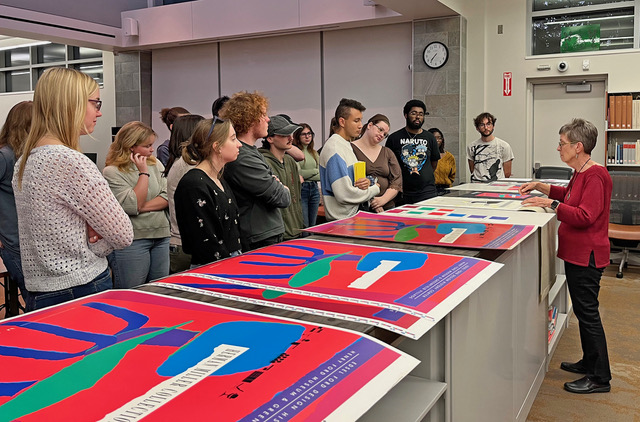Archives Tour Helps Students Visualize Ideas through Design Process
November 1, 2024
In early October, twenty-five junior students from the Western Michigan University Graphic Design Program made an in-person visit to the archives. In preparation, Instructor of Graphic Design Brian Edlefson had chosen more than 20 items from the collection, spanning the 1940s to the present.
“I wanted students to review the primary sources,” Brian explains; “to experience the textures, colors, and scale of design work beyond the boundaries of their laptop screens. The class is focused on the cultural context of graphic design and reviewing a selection of pieces from different designers and eras helps to illustrate the social and technological movements that affect the designers and their work.”
Barbara Loveland and Linda Powell, co-founders of the West Michigan Graphic Design Archives, presented information about each of the pieces selected from the collection. Brian says there’s a “rich collection of related materials with some projects. Linda Powell included a collection of torn paper sketches made in the development of the Henry Ford Herman Miller poster she designed. These one-of-a-kind pieces helped students visualize how ideas move through the different stages of the design process—from small pencil sketches to paper mock-ups and then to printer’s proofs.

“I can’t think of another opportunity to view this type of ephemera—even prestigious museums rarely reveal these ‘behind-the-scenes’ materials.” The photo shows Linda discussing the pre-computer design process, including pencil sketch, black-and-white prototypes, color studies with Pantone papers, color prototype, keyline, ink drawdowns, first and second Kodak color proofs, press proofs, and the final poster.
Archivist Lynn Houghton also gave a tour of “the “box,” the large, climate-controlled area that houses the entire collection of over 1,000 pieces.
“I was pleased,” Brian says, that the students “were so engaged; they all mentioned how useful it was to get closer to the pieces—even though many had visited the website. Many affirmed that the archives provided a more tactile, sensory way to interact with history. It adds depth to the survey information textbooks and websites aggregate.
“Several designers selected pieces from the archives to generate ideas for class projects—interpreting the source materials with new perspectives. I hope students gain a sense of their place in a longer continuum. The archive reinforces that previous designers have dealt with tremendous advancements in technology. Today’s designers can reflect on the impact and evidence they, through their work, will leave for future generations.”

